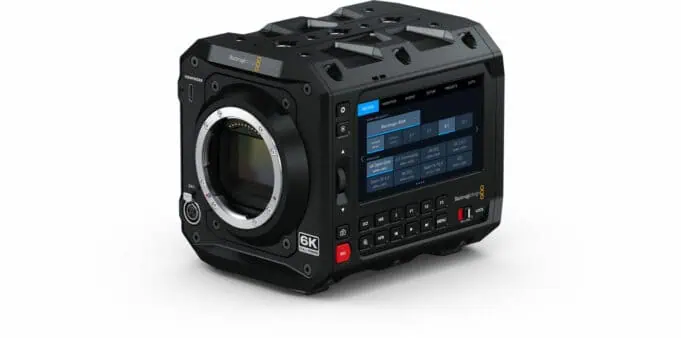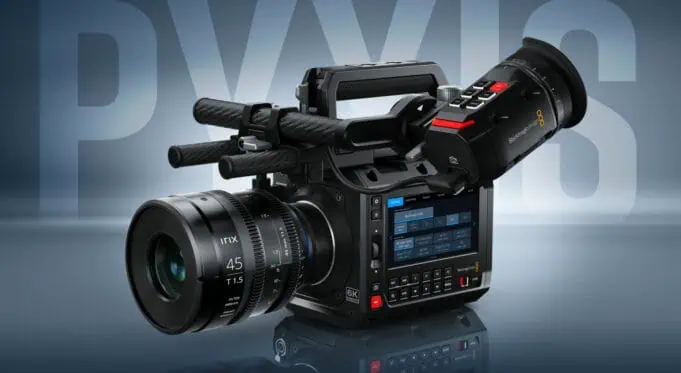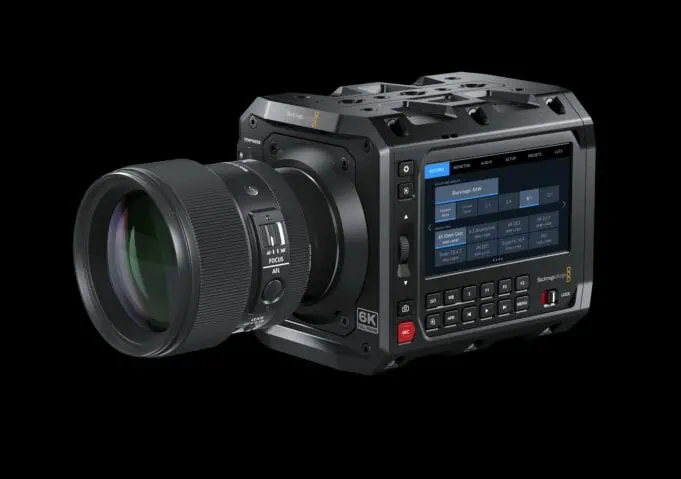Dubbed “a high end digital camera” on the just-launched product page, the Blackmagic Design PYXIS 6K may just be the box style cinema camera everyone has wanted the company to make for years. There’s a lot to like here. But there’s also a major caveat. More on that in a sec.
The reveal was part of Blackmagic’s NAB 2024 announcements, an annual broadcasting conference in Las Vegas that kicks off today. Over an epic one hour and forty five minute live stream, CEO Grant Petty passionately introduced one product after another. Indeed, there were a lot of toys! Well, actually professional broadcast and A/V gear including switchers, color panels, editing accessories and a bunch of new (and pretty slick) cloud stuff.
One nifty thing introduced in DaVinci Resolve is a film look module. There you can find all sorts of options to grainify and filmify (my words) your staid, digital files. It looks quite compressive and I like the interface. Well done.
Like many, though, I was watching expressly for the cameras segment which came last, about one hour into the presentation.
There we privy to two new camera announcements:
- Blackmagic URSA Cine 12K
- Blackmagic PYXIS 6K
Priced at from $15,000 USD, the new URSA Cine 12K will look familiar to those who follow Blackmagic. It’s a traditional cine camera design. But, this time, with a massive 12K sensor. It really is wild the size of this thing. For a lot of specialty applications such as wildlife, science, certain corporate or medical projects, I think this will be highly desirable. For classic narrative, I’m not so sure — nevertheless there is a Super 35 mode which should do the trick.
Being a large format sensor there’s lots of flexibility. Per Blackmagic you can, for instance, shoot in 3:2 open gate, 16:9, 17:9, 2:4:1 and 6:5 anamorphic.
You might be slightly panicked at the data rates this kind of camera produces (and justifiably so!). The Blackmagic team hears you. In an interesting bundling decision, the URSA Cine comes ready to shoot and includes, most notably, an also massive 8TB media module. That’s enough memory to capture 4 hours of 12K. Time to upgrade your NAS I would imagine. In any case, it’s pretty impressive stuff.

But it was the second, smaller, and less pricey camera that caught my attention most.
That would be the new box style cine camera called the PYXIS 6K.
Essentially this looks, to me at least, like a re-housed Blackmagic Cinema Camera 6K which the company released last year.
Priced from $3,000 USD you get quite a lot of bang for the buck.
Conveniently, most URSA accessories will be cross-compatible including, for example, the top handle which is identical on both the URSA and PYXIS.
I won’t go into the entire litany of specs here (just go instead to the length product page on the BMD web site), however, here’s a couple of key highlights:
Blackmagic PYXIS 6K Cinema Camera
Key Features & Highlights
- 6K full frame sensor (6048 x 4032)
- 13 stops dynamic range (claimed by Blackmagic)
- ISO up to 25,600
- 36fps full sensor resolution
- 120 fps windowed
- Three models: L-Mount, EF, PL
- Dual gain ISO (400 and 3200)
- Built-in 4″ side monitor
- Side plate options for non-operating side
- Dual CFexpress Type B slots
- Option to record to external USB-C media
- Optical Low Pass Filter (OLPF)
- Power via BP-U batteries
- Proxy files (H.264) uploads to Blackmagic Cloud while recording (Apple or Android phone, ethernet supported)
- Includes full version of DaVinci Resolve Studio editing & coloring software
- Price: $2,995 USD (L-Mount, EF), $3,195 (PL)
And the marketing summary (!):
- The World’s Most Riggable Full Frame Digital Film Camera!
- Designed for Maximum Customizability!
- Get the “Hollywood Look” with Digital Film!
- Large Format Cinematic Digital Film Sensor!
- Three Great Models!
- Side Plates for Flexible Mounting Options!
- Post Production Friendly File Formats!
- Record to CFexpress Cards or External Disks!
- Blackmagic RAW The quality of RAW and the speed of video!
- Three Post Production Workflows!
- Professional Connections for Custom Rigs!
- Load Custom 3D LUTs to Recreate Film Looks!
- Get Multi Camera Shoots in Perfect Sync!
- Shoot Still Frames up to 24.6 Megapixels!
- Power from Batteries or 12V DC!
Phew. Who needs espresso anyways.
Thoughts on the New Blackmagic PYXIS 6K Cinema Camera

So, what to think of all this?
First off, man, Blackmagic is really an innovative company. The hits keep on coming.
I’m amazed at how a — relatively — small company can keep producing so many outstanding, well-engineered, and interesting products. Just astonishing frankly. And then you get to the prices, and they’re almost always far less than you might expect, especially given these are all crafted for professional scenarios.
Also, I should note that Grant Petty’s down-to-earth style is a breath of fresh air. Too often we get flashy and over-produced glitter for new products. Instead, this was kind of like hanging out with your excited Uncle, who just can’t wait to show off a bunch of cool new kit. It’s hard not to get inspired by the enthusiasm and passion. Even though I’d be a happy clam if I didn’t have to live another day to see yet another switcher-dissolver thing-a-ma-jig.
As for the PYXIS 6K?
I like that they’ve finally come up with a new product name. PYXIS. Not bad. I sort of like it and I appreciate that it much simplifies talking about this camera with respect to the existing lineup. With the previous models, such as the Blackmagic Pocket Cinema Camera 6K Pro, it took some time just figuring out how to properly type out the product name. No doubt this might have also sowed confusion in the marketplace amongst potential buyers.
So now they have the URSA and the PYXIS.
We’d be hard-pressed when talking about the new PYXIS without mentioning the RED Komodo and Komodo-X, clearly the obvious competition here.
As expected, Blackmagic undercuts both the Komodo ($5,995) and Komodo-X ($9,995) with the PYXIS ($2,995). Par for the course. Value-to-price has long been their hallmark.
Other key differences include the sensor. Blackmagic is a 6K full frame sensor whereas the Komodo is a 6K Super 35. In terms of power the Blackmagic uses Canon BP-U batteries while the Komodo uses Sony NP-F and the Komodo-X uses (my preference) V-Mount.
Let’s also not forget that the extra price tag for Komodo-X gets you higher dynamic range and also that utopian of desires for aspiring YouTubers everywhere: a global shutter.
Also to note, the built-in monitor on the PYXIS is located on the left side. On Komodo it’s on top. Both are fixed.
And that brings me to me first slight bummer about this otherwise incredible looking new camera body: the fixed monitor. From what I saw today there’s no hinge or way to swing it out. Design-wise this might seem intended for small crews with dedicated operators who can interact from the camera, as typically seen on sets, from the side. For solo shooters, content creators and owner-operators this could present a problem. How do you adjust camera settings like white balance, ISO, LUTs, etc. while on the run? I’m hoping there’s an obvious solution. Perhaps using your phone and BM app would work, or some sort of combination of using the built-in screen, in addition to a top-mounted monitor? Then again, maybe I’m overthinking all of this. Just use the built-in screen to adjust settings for that particular scene. And then just shoot it using external monitor on top like any other camera.
And, for the record, from the press release here’s how Blackmagic themselves describe the built-in LCD:
“The built in LCD on Blackmagic PYXIS is more than just a simple status display. It’s a 4″ high resolution HDR touchscreen that is also perfect for monitoring and reviewing shots on set. Its full HD resolution means customers can frame and focus their shots without needing to carry around a bulky external monitor. Customers can even use the display as a focus assist station.”
Either way, for what you get for the money I think this is a small (yet important) issue to consider. I just wish they had hinged this thing, like they do on their Pockets.
Others will likely take issue with the lack of built-in ND filters, as found on the URSA. At first glance a vertical dial on the camera body located where built-in ND controls are typically located on cameras from Sony and Canon and others had me thinking there was built-in ND. Instead, that’s a control dial used to interact with settings. Not a big deal for me. I have plenty of ND filters, and have grown accustomed to hauling them along, begrudgingly, on outdoor shoots. Besides, Komodo also doesn’t have them.
I have to say, overall, I’m intrigued.
If you’re in the market for a RED (Nikon) Komodo/Komodo-X I suspect you’ll at least want to cross-shop the PYXIS, and maybe even the new URSA Cine depending on your projects and budget.
I was looking for a compact, travel-friendly cinema camera to complement my aging, but still stellar, RED Scarlet-W. My back is begging for it. Naturally, the Komodo-X is a great option. I like that the former RED team took all the great stuff from the original Komodo and refined it: CFexpress Type B media (instead of Cfast), V-Mount (instead of Sony Np-F), among other improvements. But now with PYXIS there’s a much lower priced option. Those savings could then, obviously, find there way into a number of completely unnecessary and ridiculously cheap cinema glass manufactured in China. (I love this trend, to hell we go).
RELATED ARTICLE:
Do I suddenly own a Nikon Cinema Camera?
Make my PYXIS the L-Mount. Highly adaptable that one. No problem using an adapter for EF lenses, or C-mount vintage stuff, or Nikon, among others. Behold! I should also mention that the PYXIS has a Super 16 mode (2,112 x 1,184).
Still, I wonder about that fixed-in-place side monitor. How to work around that?
At the end of the day we should be thankful a company like Blackmagic and products like these exist. All of this competition is healthy for the market. And it gives us all so many incredible choices when it comes to finding excuses to buy more cameras and lenses… and cameras and lenses… and lenses… and cameras… and maybe some batteries… (boring)… and cameras and lenses… and…
The Blackmagic PYXIS 6K is expected to ship June 2024. If you’re at NAB in Vegas, go to booth #SL5005 to check out the PYXIS 6K.


